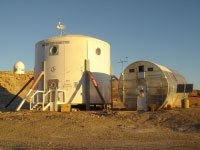The Mars Society is an international non-profit organization founded in 1998 by Dr. Zubrin and others and is dedicated to furthering the goal of exploration and the eventual colonization of the planet Mars. The society plans on achieving this goal through broad public outreach to instill the vision of pioneering Mars, by supporting more aggressive government funded Mars exploration programs around the world, and conducting Mars exploration on a private basis. More information is available on The Mars Society's website and the society's Founding Declaration. The members of the society are from all walks of life from scientists such as Dr. Christopher McKay, award winning filmmaker James Cameron, former NASA astronauts Buzz Aldrin and Scott Horowitz to scientists, engineers, plumbers, electricians, farmers, teachers and students. It is estimated that the society has over 4000 members and over 6000 associate supporters in over 50 countries around the world. The Mars Society has chapters in countries around the world including the USA, Canada, Austria, the Netherlands, Germany, France, Italy, Belgium, Poland, Spain, Mexico, Australia, and the United Kingdom.
To further the cause the society gives presentations on Mars Direct, promotes the teaching of science, astronomy and spaceflight related subjects in schools, campaigns for greater investment in space research, hosts annual conferences on Mars exploration and actively supports NASA, ESA and other space agencies in their on-going exploration of Mars.
Some of the society’s more notable technical projects include:
The Mars Society operates two Mars analog research stations: the Flashline Mars Arctic Research Station (FMARS) in Devon Island, Canada and the Mars Desert Research Station (MDRS) in Utah. Two additional stations are to be built in Europe (Euro MARS) and in Australia (Mars Oz). The purpose is to develop field tactics in Mars-like extreme environments simulating missions on the surface of Mars. I will post a more detailed account of the MARS Program in the next couple of days.
The Mars Gravity Biosatellite project is a joint venture of the Georgia Institute of Technology, the University of Queensland, and MIT. It began as a Mars Society initiative called Translife in 2001. The project's mission is to investigate the effects of Mars-level gravity on mammals by studying mice in Earth orbit in an artificial gravity (i.e. spinning) satellite.
Archimedes is a small interplanetary space probe currently slated for launch to planet Mars in 2009. The probe is designed as a helium balloon ten meters in diameter. The onboard suite of scientific instruments is primarily geared towards the analysis of the atmospheric conditions on Mars. The device follows a payload proposal by the German Mars Society for a ride on AMSAT’s P5-A Mars orbiter.
Travel to Mars will take 6 months and current experience has shown that the zero gravity conditions will cause the astronauts muscles and bones to atrophy along with many other health effects. The TEMPO3 experiment is the first attempt to use a tether to generate artificial gravity for the crew and allow them to arrive at Mars physically fit for the busy schedule they will have on the surface.
Is an annual event where teams must build robotic assistants that will work with astronauts on future missions to the Red Planet performing a number of critical tasks. In particular, teams must tele-operate their rovers to: service an equipment panel, scout for and survey several remote markers, rescue a distressed astronaut in the field, and perform scientific reconnaissance in search of signs of life.
Spaceward Bound is an educational program organized at NASA Ames in partnership with The Mars Society. The focus of Spaceward Bound is to contribute to the training of the next generation of space explorers by having students and teachers participate in the exploration of scientifically interesting but remote and extreme environments on Earth as analogs for human exploration of the Moon and Mars. The program has been ongoing since 2006. The program is funded by NASA's Exploration Systems.
Content and all photographs are from The Mars Society's website http://www.marssociety.org/.







1 comment:
Post a Comment